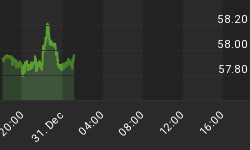The money supply as measured by M2 is now rising at a 12.1% annualized rate, which is causing the fickle Fed to renew its threats about ending QE. The minutes released from the latest FOMC meeting indicate the tapering of asset purchases could once again begin within the next few meetings.
Could it be the Fed is finally getting concerned about the asset bubbles it so desired to create? The robust increase in money supply has pushed stock prices higher; you could also throw in diamonds, art, real estate and Bitcoins to name just a few assets that are in raging bull markets. All those items just mentioned are not counted in the CPI measurement and therefore allow most on Wall Street and in D.C. to claim there is no inflation.
But despite promises from the Fed that tapering (when and if it ever comes) isn't tightening monetary policy, the Ten Year Note just isn't a believer. That benchmark yield was trading below 2.70% before the FOMC minutes were released, and then shot up to 2.84% within 24 hours of learning the taper talk was back on again; clearly illustrating the enormous pent-up pressure on bond yields.
So what you may say? Aren't rising yields a sign of a healthy economy? Perhaps under normal conditions that is true. But in sharp contrast, today's rising yields are the result of the combined forces of inflation and tapering fears. In reality, ending QE is all about the government relinquishing its utter dominance of the bond market.
However, the fear over the imminent end of easy money is for the most part unfounded. And even if the Fed were to curtail QE sometime in the near future, it would only last briefly; and the tightening policy would have to be quickly reversed, as I believe the entire globe would quickly sink into a deflationary depression. Precious metal investors may have to wait until the attempted exit from QE fails before a major, and indeed, record-setting advance can occur.
In addition, the odds are also increasing that Janet Yellen (whom I have dubbed the counterfeiting Queen) will allow asset bubbles to increase to a much greater degree than her predecessor, Ben Bernanke ever did. And that should drag commodities along for a nice ride. After all, the gold market has been busy pricing in the end of QE for multiple quarters. There is a good chance that the beginning of tapering would lead to a reversal of the trade to sell gold ahead of the news. But the major averages have priced in a sustainable recovery on the other side of QE, which will not come to fruition. For the Dow, S&P 500 and NASDAQ the end of QE will be especially painful.
But the truth is the U.S. economy is more addicted to the artificial stimuli provided by the Fed and government than during any other time in our nation's history. Aggregate debt levels, the size of the Fed's balance sheet, the amount of monthly credit creation and the low level of interest rates are all in record territory at the same time. This condition has caused the re-emergence of bond, stock and real estate bubbles all existing concurrently as well.
A unilateral removal of stimulus on the part of the Fed will send the dollar soaring and risk assets plunging -- you could throw in emerging market equities and any other interest rate sensitive investment on planet earth. The Fed is aware of this and that is why it is desperately trying to deceive the market into believing ending QE will not cause interest rates to rise. This is a silly notion. Since QE is all about lowering long-term rates how can it be that ending QE won't cause the opposite to occur? This is why the FOMC minutes released today show that the Fed is debating different tactics to run in conjunction with the taper; such as charging banks interest on excess reserves in an attempt to offset the deflationary forces associated with tapering asset purchases.
Nevertheless, the most important point here is most money managers on Wall Street are convinced this is an economy that is on a sustainable path -- but they are completely wrong. Disappointingly, it is much more probable that the government has brought us out of the Great Recession only to set us up for the Greater Depression, which lies just on the other side of interest rate normalization.
Sadly, the Fed has killed the buy and hold theory of investing for many years to come. Having an investment strategy for both rampant inflation and sharp deflation is now essential at this juncture.
















